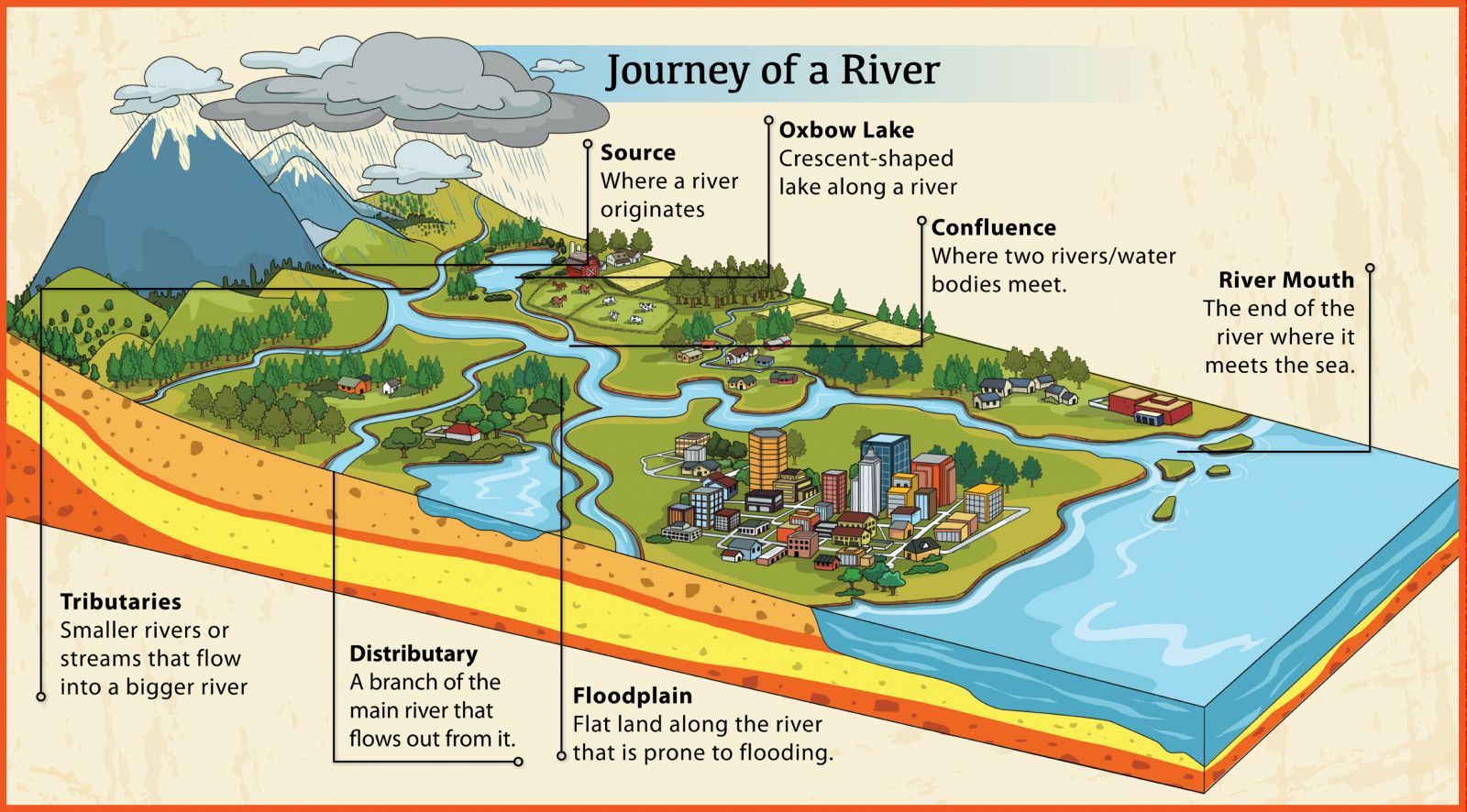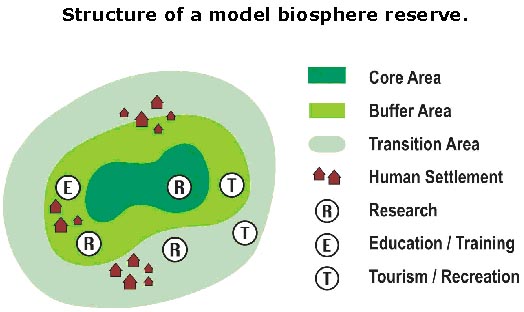-
Chapter 7: EARTH
Lithosphere
Lithosphere is broken into
many small plates. These plates move around due to the
motion of magma inside the earth. This motion leads to
plates moving a few millimeters each year. The movement of
these plates causes changes on the surface of the earth.
The earth movements are divided on the basis of the forces
that cause them.
1.
Endogenic
forces: acting in the interior of the earth.
E.g. Earthquakes, landslides, building mountains,
volcanoes.
2. Exogenic forces: acting on the surface of the earth. E.g. Rivers, winds, glaciers, sea waves.
Work of a river:
A river erodes the landscape due to the running water. When a river tumbles over a very steep rock or down a river valley it forms a waterfall. As the river enters a plain it twists and turns to form large bends known as meanders. Due to endless deposition and erosion the ends of the meander loop come closer and closer and finally form an ox bow lake which is cutoff from the river. If the river overflows the banks it deposits fertile soil or other elements along its banks called sediments. This leads to formation of a flood plain.
As the river closes to the sea its speed becomes slower and the sediments it carried are deposited. This leads to a breakup of the river into distributaries and each distributary forms a mouth. The collection of sediments from all mouths are called delta.
Glaciers
too carry sediments like rocks, sands which are deposited
on the path, these are called glacial
moraines.
Even winds act as weathering agents, winds lifts and
carries sands from one place to another. When the wind
stops blowing the sands are deposited. Such sand deposits
on large areas are called loess.
Conditions favoring formation of Delta
- Active vertical and lateral erosion to provide sediments that shall be deposited at deltas.
- Preferrably sheltered and tideless coast.
- Sea adjoining delta should be shallow
- There should be no large rivers in the course to filter off the sediments.
- There should be no strong current flowing at right angles at the mouth of the river, washing away the sediments.
Estuaries are better than deltas for formation of ports as deltas see deposition of large quantities of silts thus preventing large ships from setting up anchor near ports.

Course of a river:
Upper course / Mountain course [stage of youth]: V-shaped valleys, gorges or canyons are formed. Rapids, cataracts or waterfalls also occur mostly in this stage but can also occur in lesser numbers in the next stages also.
Middle course / valley course [stage of maturity]:Interlocking spurs and meandering flow is seen. Also river cliffs and slip off slopes are common.
Lower or plain course [stage of old age]:Flood plains are seen at this stage and banks of the river are raised due to deposits forming leeves. Delta and ox bow lakes are also seen.
Land use patterns:
Japan has 67% of its total land under forests, Canada has 52% of its land under developmental use, India has 56% of its area under cultivation and Australia has 56% of its area under pastures.
|
Push factors |
Pull factors |
|
Over population |
Employment |
|
Religious persecution |
More opportunities |
|
Slavery or bonded labor |
Better social amenities |
|
Lack of food |
Better lifestyle |
|
Racial discrimination |
Continuous trade and economic expansion |
|
Natural hazards / climate change |
Territorial expansion |
|
Fragmentation of family owned land |
|
Table 1: Push and pull factors responsible for migration from villages to cities
Solar System and Planets:
1. Mercury: closest to the sun but no atmosphere.
2. Venus: closest to the earth. Atmosphere has CO2 and poisonous gases.
3. Mars: red planet or earth’s twin.
4. Jupiter: largest planet but not with any solid surface
5. Saturn: gaseous planet with a ring.
6. Uranus: highly tilted rotation axis.
7. Neptune: cold and dark surface. Smaller than earth.
Four
inner planets are rocky with less number of satellites
and outer planets are gaseous with many satellites.
Protected areas:
Biosphere reserves:
It is a unique and representative ecosystem of terrestrial and aquatic areas. These are recognized under the UNESCO's man and biodiversity program. There are currently 18 reserves out of which 10 are recognized by UNESCO’s world network of biosphere reserves viz. Nilgiri, Nandadevi, Sunderban, Nokrek, Similipal, Panchmarhi, Amarkantak, Agastyamala, Great Nicobar and Gulf of Mannar.
The biosphere reserves have three areas:
· Core: here no human activity is permitted. No entry is allowed except with permissions for special purposes only.
· Buffer: here greater variety of resource use strategies, research and educational activities are permitted.
· Transition zone: it is an area of active cooperation between reserve management and local people. Here economic activities are permitted if they are in sync with conservation goals.

Fig 2: Biosphere reserves
Fossil fuel formation:
- Coal, oil, natural gas are the major fossil fuels in the world. Coal formation goes through the following stages:
- Stage 1 [peat]: partially decayed plant matter in swamps. It has low heat content.
- Stage 2 [lignite]: low cost, low sulphur and low heat content.
- Stage 3 [bituminous]: Generally used as fuel due to high heat content.
- Stage 4 [anthracite]: hard coal with low sulphur and high heat content.
- Oil and gas are found along geologically young tectonic belt at plate boundaries where depositional basins are more likely to occur.
Bio-fuel:
Bio-fuel is obtained by converting biomass into alcohol to be used as fuel. Jatropha and Pongamia are plants that can be used to obtain bio-diesel.
Ethanol obtained from sugarcane, sorghum can be used as a substitute for petrol.
Solved Question Papers
Q. In India, the problem of soil erosion is associated with which of the following?
Terrace cultivation
Deforestation
Tropical climate
Select the correct answer using the code given below. (UPSC CSAT 2014)
1 and 2 only
2 only
1 and 3 only
1, 2 and 3
Ans . B
Terrace Cultivation helps reduce soil erosion
Q.Lichens, which are capable of initiating ecological succession even on a bare rock, are actually a symbiotic association of (UPSC CSAT 2014)
algae and bacteria
algae and fungi
bacteria and fungi
fungi and mosses
Ans . B
In organisms called lichens, a chlorophyll-containing partner, which is an algae, and a fungus live together fungus provides shelter, water and minerals to the alga and, in return, the alga provides food which it prepares by photosynthesis
Q.With reference to two non-conventional energy sources called ‘coal bed methane’ and ‘shale gas’, consider the following ‘statements:
Coal bed methane is the pure methane gas extracted from coal seams, while shale gas is a mixture of propane and butane only that can be extracted from fine-grained sedimentary rocks.
In India abundant coal bed methane sources exist, but so far no shale gas sources have been found.
Which of the statements given above is/are correct? (UPSC CSAT 2014)
1 only
2 only
Both 1 and 2
Neither 1 nor 2
Ans . D
Shale gas contains methane along with "propane and butane".
Shale gas resources exist in India.
Q.In India, cluster bean (Guar) is traditionally used as a vegetable or animal feed, but recently the cultivation of this has assumed significance. Which one of the following statements is correct in this context? (UPSC CSAT 2014)
The oil extracted from seeds is used in the manufacture of biodegradable plastics
The gum made from its seeds is used in the extraction of shale gas
The leaf extract of this plant has the properties of anti-histamines
It is a source of high quality biodiesel
Ans . B
Chapter Review
Score more than 80% marks and move ahead else stay back and read again!